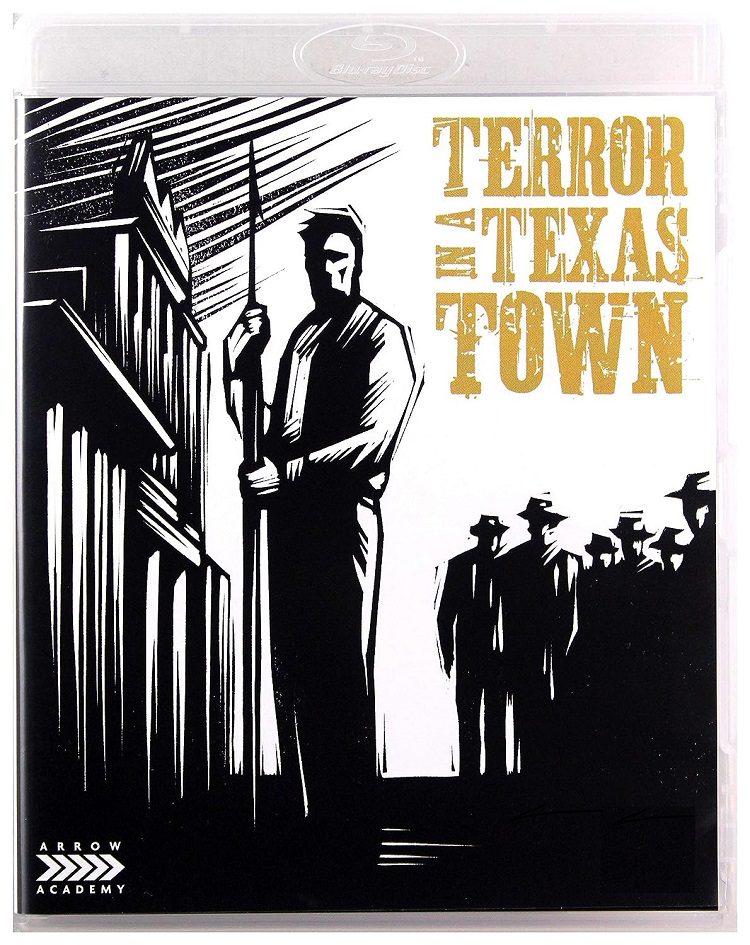
Though he mostly helmed B-grade crime dramas, Saturday matinee western oaters, and early entries in what would eventually become a part of The Bowery Boys legacy, director Joseph H. Lewis nevertheless made several notable contributions to the world of film noir. One such title was 1950’s Gun Crazy, which writer Dalton Trumbo was forced to employ a front for due to the fact he had been blacklisted by the McCarthy Era witch hunts. Appropriately, the writer and director would pair once more in 1958 for Lewis’ final theatrical film: a nifty little B-grade western film noir sporting a parallel or two to the current political circus of the time.
The result, Terror in a Texas Town, is the very sort of film that deserves more attention than it has received in the decades that have since passed. Here, the one and only Sterling Hayden ‒ in one of his strangest roles ‒ plays an awkward Swedish sailor (!) who is ready to start a new life in a small Texan community where he and his father own a ranch. Unfortunately, the shadow of death has already beat him to this tiny village in the Old West: his father having been mercilessly gunned down only days prior by an aging, bitter gunslinger who has been contracted to do a little cleaning at the behest of an evil local businessman.
Now, while that may sound like pretty straightforward oater stuff right there, Terror in a Texas Town sports that unique filter of darkness and desperation normally only seen in grittier noir films. And from the bookended finale which opens the tale, wherein we bear witness to one of the most unique showdowns in cinematic history ‒ two six-shooters versus one whaling harpoon ‒ we know we’re in for a treat. This becomes all the more apparent once we learn the correct context of said scene is deliberately misleading; it is only as Trumbo’s story unfolds that we discover the true meaning behind the seemingly surrealistic confrontation.
Damaged dames, reflective psychopathic villains, and a protagonist who is pushed too far all add to the darker side of this somewhat neglected gem. Starring opposite Sterling Hayden (who, interestingly enough, had testified before the House Un-American Activities Committee, a supposedly patriotic gesture which he would later look back at with much regret ) is the deadly duo of fifth-billed Ned Young (who had been blacklisted by the HUAC; a sanction that had lifted by the time this film went into production) as the hired gun with a secret steel hand, and the great Sebastian Cabot as the wealthy corrupt hotel owner determined to own all of the land.
Interestingly, Cabot played the exact same role in the strangely similar Black Patch the previous year. In that title, Tom Pittman played an itchy-fingered psycho whom the community was horrified to discover had a natural deadly talent when the first rapid-fire handgun is introduced. Ned Young’s gunfighter in Terror in a Texas Town, on the other hand (heh), is a battle-scarred creature who must come to grips (ha-ha) that his ilk are fast becoming a thing of the past, such as when he finally meets a man who is not afraid to die. It’s a stark contrast in complex supporting villains, so much so that I heartily recommend viewing both films back-to-back.
Also appearing in this dark and dusty ditty are Carol Kelly, Eugene Mazzola, Victor Milan, and western regular Frank Ferguson. Seasoned B-movie players Byron Foulger, Tyler McVay (as the bought-and-paid-for sheriff, whose exit is a fitting metaphor for our current political circus), and Glenn Strange make uncredited cameos in this enthralling thriller. Like director Lewis, Terror in a Texas Town would prove to be the last big-screen project for several members of the cast and crew, including director of photography Ray Rennahan. Gerald Fried provides the odd (sometimes patronizing) music score.
After being out of print for nearly 15 years, Terror in a Texas Town returns to terrorize anew via Arrow Academy’s beautiful 1080p 2k restoration. Apart from the fact the low-budget United Artists release incorporated some (rather old and well-worn) stock footage, Lewis’ mini-masterpiece looks better than ever. The amusing tendency of the late director to diminish the presence of his performers by including a stationary object in the front of the frame (a motif which earned him the illustrious nickname of “Wagon Wheel Joe” in his early directorial days) is the sort of thing which can be appreciated much better in black-and-white High-Definition.
An LPCM 2.0 Mono English audio soundtrack accompanies our main feature, as do optional (SDH) subtitles. Special features for this Arrow Academy Blu-ray are limited, as one might imagine with such a niche selection, but make for educational viewing nevertheless. Two newly-produced featurettes with western movie historian/author Peter Stanfield form the bulk of the bonus goodies, hosting an introducing to the film (in which he adequately refers to Joseph H. Lewis as a “stylist without a theme”) before returning to offer us A Visual Analysis. Both extras run in the neighborhood of just under 15 minutes each, and deserve your attention.
Lastly on this Arrow Academy release is the film’s original theatrical trailer. While it has also been remastered in HD, said preview hails from that awkward, early moment in our modern digital world wherein MGM sort of forgot to add the titles back to many of the the films/trailers they had restored for release DVD, so there are no titles to be seen in the trailer (something MGM has never bothered to rectify). First pressings of this Arrow Academy release include a collectible booklet with an essay by Glenn Kenny, and the newly-commissioned artwork by Vladimir Zimakov on the disc’s reversible sleeve holds up quite well with the film’s minimalist style.
Highly Recommended.